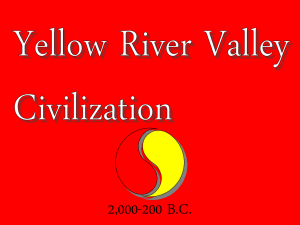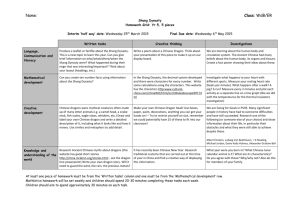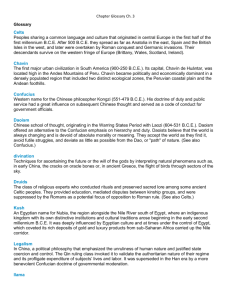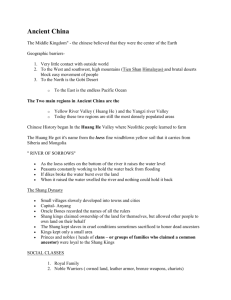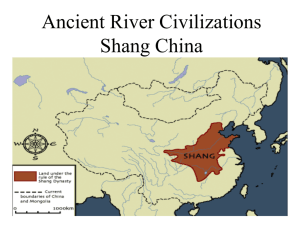1285783085_433956
advertisement
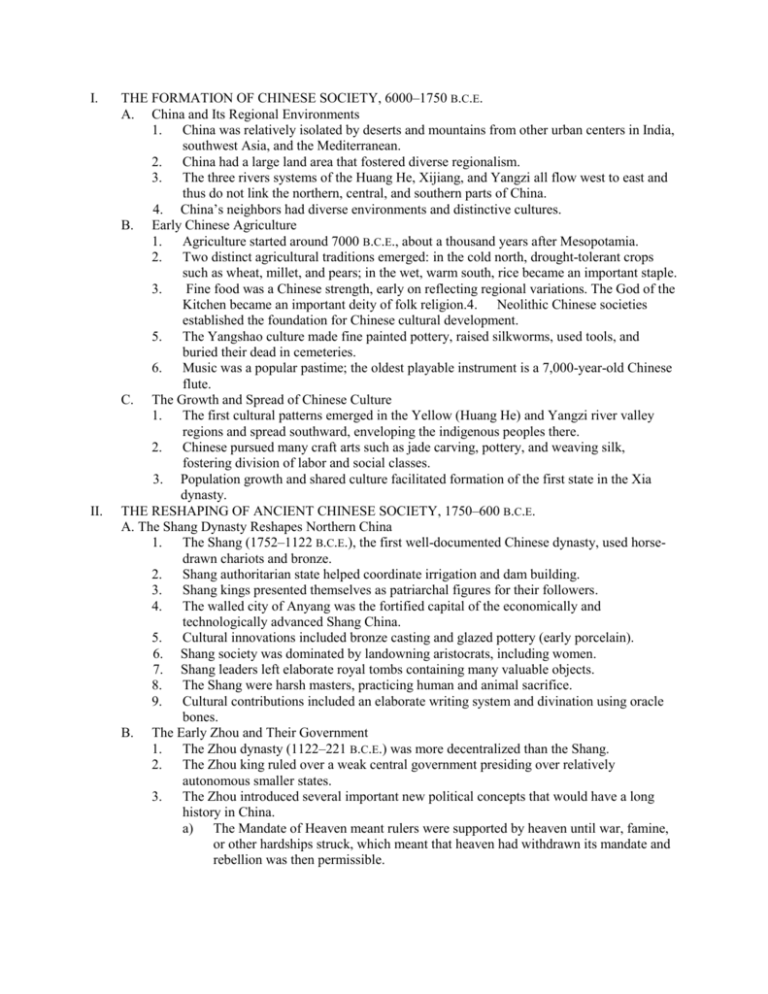
I. II. THE FORMATION OF CHINESE SOCIETY, 6000–1750 B.C.E. A. China and Its Regional Environments 1. China was relatively isolated by deserts and mountains from other urban centers in India, southwest Asia, and the Mediterranean. 2. China had a large land area that fostered diverse regionalism. 3. The three rivers systems of the Huang He, Xijiang, and Yangzi all flow west to east and thus do not link the northern, central, and southern parts of China. 4. China’s neighbors had diverse environments and distinctive cultures. B. Early Chinese Agriculture 1. Agriculture started around 7000 B.C.E., about a thousand years after Mesopotamia. 2. Two distinct agricultural traditions emerged: in the cold north, drought-tolerant crops such as wheat, millet, and pears; in the wet, warm south, rice became an important staple. 3. Fine food was a Chinese strength, early on reflecting regional variations. The God of the Kitchen became an important deity of folk religion.4. Neolithic Chinese societies established the foundation for Chinese cultural development. 5. The Yangshao culture made fine painted pottery, raised silkworms, used tools, and buried their dead in cemeteries. 6. Music was a popular pastime; the oldest playable instrument is a 7,000-year-old Chinese flute. C. The Growth and Spread of Chinese Culture 1. The first cultural patterns emerged in the Yellow (Huang He) and Yangzi river valley regions and spread southward, enveloping the indigenous peoples there. 2. Chinese pursued many craft arts such as jade carving, pottery, and weaving silk, fostering division of labor and social classes. 3. Population growth and shared culture facilitated formation of the first state in the Xia dynasty. THE RESHAPING OF ANCIENT CHINESE SOCIETY, 1750–600 B.C.E. A. The Shang Dynasty Reshapes Northern China 1. The Shang (1752–1122 B.C.E.), the first well-documented Chinese dynasty, used horsedrawn chariots and bronze. 2. Shang authoritarian state helped coordinate irrigation and dam building. 3. Shang kings presented themselves as patriarchal figures for their followers. 4. The walled city of Anyang was the fortified capital of the economically and technologically advanced Shang China. 5. Cultural innovations included bronze casting and glazed pottery (early porcelain). 6. Shang society was dominated by landowning aristocrats, including women. 7. Shang leaders left elaborate royal tombs containing many valuable objects. 8. The Shang were harsh masters, practicing human and animal sacrifice. 9. Cultural contributions included an elaborate writing system and divination using oracle bones. B. The Early Zhou and Their Government 1. The Zhou dynasty (1122–221 B.C.E.) was more decentralized than the Shang. 2. The Zhou king ruled over a weak central government presiding over relatively autonomous smaller states. 3. The Zhou introduced several important new political concepts that would have a long history in China. a) The Mandate of Heaven meant rulers were supported by heaven until war, famine, or other hardships struck, which meant that heaven had withdrawn its mandate and rebellion was then permissible. b) The dynastic cycle became the way of viewing politics: initially a period of peace and prosperity; then overexpansion, corruption, and rebellion; and finally a new dynasty that starts the cycle again. C. Early Zhou Society and Economy 1. Zhou society was rigidly divided between classes and genders. 2. Women played no official part in public affairs and were expected to be submissive. 2. Iron technology reached China from Central Asia by about 700 B.C.E. 4. Social life revolved around food. D. The Evolution of Chinese Writing and Religion 1. Writing evolved to solve the problem of diverse local dialects, a result of Chinese regionalism. 2. Northern Mandarin dialects are closely related, but in the south, regional dialects are mutually unintelligible. 3. Written Chinese developed from pictographs to ideographs, which have since expanded to include 50,000 characters. 4. A common, artistically pleasing writing system promoted political and cultural unity in China. 5. The Yijing (Book of Changes) was a system of divination based on 64 hexagrams that Chinese could use to predict future events with the belief that heaven and earth are continually changing. 6. Chinese cosmology developed the idea of the complementary opposition between yin and yang. a) Yin is dark, cold, wet, and feminine. b) Yang is light, warm, dry, and masculine and was superior to yin, as male was superior to female. III. ANCIENT SOUTHEAST AND NORTHEAST ASIANS A. Southeast Asian Environments and Early Agriculture 1. Shallow seas encouraged trade, fishing, and maritime skills. 2. Heavily forested highlands throughout the islands of Asia divided cultures, encouraging cultural diversity. 3. Rice was probably domesticated in China and then spread into Southeast Asia. 4. Southeast Asians may have been the first to cultivate bananas, yams, and taro, as well as to domesticate chickens, pigs, and cattle. 5. Bronze-working appeared very early, before 2000 B.C.E., for uses such as producing huge drums. B. Migration and New Societies in Southeast Asia and the Pacific 1. Sea-borne trade led by Austronesian-speaking Indonesians linked Vietnamese, Papuans, Melanesians, and Negritos. 2. Austronesians introduced domesticated pigs and dogs, grew rice and millet, and established tattooing as a common practice. 3. Migration fostered some of the oldest links between peoples over a wide area of Asia. 4. By 1000 B.C.E. dynamic Austronesian trade networks stretched 5000 miles across the Pacific, forming a commercial system unparalleled in the ancient world. 5. Animism held a major presence among religious beliefs in ancient Southeast Asia. C. The Foundations of Korea and Japan 1. Korea is a mountainous peninsula 600 miles long and 150 miles wide. 2. Japan consists of 3,400 islands across several climatic zones. 3. Korean population growth generated much migration to Japan. 3. Koreans adopted rice growing to their cooler climate. 4. Koreans were never assimilated by the Chinese, in part because their languages are very different. 5. Koreans developed radiant stone floor heating to overcome the cold long before the Chinese and Romans developed similar schemes. 6. Japanese pottery is among the oldest in the world. 7. The Japanese are genetically linked to the Siberians, Koreans, and the Ainu, whose ancestors may have also settled North America. D. Jomon Society 1. The Jomon (“rope pattern”) society, 10,000 to 300 B.C.E., is the best documented early Japanese society. 2. The Jomon lived in permanent wooden houses with elaborate hearths, where they probably had family gatherings and ate a well-balanced diet of nutritious foods acquired by hunting, gathering, and fishing. 3. The Japanese language, distantly related to modern Korean, is adept at tact and vagueness and reflects a part of the Japanese heritage: a penchant for nonverbal understanding and sensing moods to deflect conflict. IV. ANCIENT AMERICANS A. Diverse American Environments 1. The Americas form a north-south axis, unlike the east-west axis of Eurasia. 2. The land mass of the Western hemisphere is smaller than Eurasia, but it is just as diverse with woodlands, deserts, grasslands, mountains, and rainforests. 3. The Rocky Mountains and Andes created an east-west barrier in the Americas. B. The Antiquity and Migration of Native Americans 1. Modern Native Americans are thought to be descended from stone-tool-using Asians, though their ancestry and dates of arrival in the Americas is subject to scholarly debate. 2. The Ice Age lowered sea levels to create a land bridge across the Bering Strait from Siberia to Alaska. 3. Modern DNA testing and comparison of blood and teeth types establishes a close similarity between modern Native Americans, revealing a common ancestry. 4. There is sparse and controversial evidence for ancient migrants also coming from Australia, Southeast Asia, and Europe, but if they did make the voyage, they were absorbed into the larger population of the Americas. 5. The Clovis culture, c. 11,500 to 13,500 years ago, named after spear points discovered in New Mexico, was considered the earliest culture in the Americas, but this is disputed by other sites in Chile, Mexico, and the United States (Pennsylvania, South Carolina, Texas, and Virginia). 6. Large herbivore animals such as horses, mammoths, and camels disappeared from the Americas between 9000 and 7000 B.C.E. most likely because of a combination of overhunting, environmental change, and an apocalyptic disease. 7. Hunting of bison continued in North America up to the nineteenth century C.E. 8. By 4000 B.C.E., extensive long-distance trade networks over land and rivers with dugout canoes linked people across thousands of miles throughout what is now the Central and Eastern United States. C. Early Societies and Their Cultures 1. Egalitarian bands linked by kinship and marriage often hunted cooperatively. 2. Native American religions had many shared features, including reverence of the foodproducing earth and similar creation stories. 3. Some societies built huge earthen mounds such as the site at Poverty Point, Louisiana, occupied between 1000 and 500 B.C.E., where the largest mound was built in the effigy of a bird that can only be seen from the air. D. The Rise of American Agriculture 1. E. F. G. Though they were among the earliest farmers, American peoples were vulnerable to El Niño, periodic weather change caused by warming of the Pacific Ocean, leading to droughts. 2. Americans were able to overcome harsh climates, forming three basic agricultural patterns. a) Farmers in Highland and valley regions of Mesoamerica focused on labor-intensive maize as well as beans and squash. b) Those in the high altitude Andes grew potatoes and frost-resistant tubers. c) The tropical forest societies in South America grew manioc, sweet potatoes, and root crops. 3. Americans domesticated more different crops than all the Eastern Hemisphere peoples combined, including varieties of maize (corn), bottle gourds, pumpkins, avocados, chili peppers, potatoes, cotton, chocolate, and tobacco. 4. American agriculture involved domestication of dogs, turkeys, and guinea pigs, as well as terracing and floating gardens, but it lacked draft animals, a plow, or wheel. 6. The lack of larger animals and the subsequently lower exposure to infectious diseases had deadly consequences after contact with people from the Eastern Hemisphere began in 1492. Farming Societies, Cities, and States 1. The inhabitants of the northern Andes made ceramics between 3000 and 2500 B.C.E., demonstrating communal activity in early villages. 2. Institutionalized religions were led by a priestly caste. 3. Several American societies developed mummification of the dead earlier than the appearance of Egypt’s more famous mummies appeared. 4. Americans also developed stepped pyramids and played ceremonial ballgames including a game involving teams attempting to knock a ball through a high stone hoop. 5. The foundation for city and state formation included agriculture, monumental construction, long-distance trade, technological breakthroughs, and population growth. 6. The population of the Americas grew from 1 or 2 million in 4000 B.C.E. to around 15 million in 1 B.C.E. South American Societies: Caral and Chavin 1. The first known city in the Americas was Caral, built in north-central Peru at about the same time as the cities of Harappa in India or the Egyptian pyramids. 2. Chavin, in northwestern Peru, emerged by 1000 B.C.E. but collapsed by 200 B.C.E., having been home to about 3,000 people at its peak. Mesoamerican Societies: The Olmecs 1. The Olmecs, the earliest known urban society in Mesoamerica, flourished along Mexico’s Gulf Coast between 1200 or 1000 and 300 B.C.E. 2. Olmec cities were probably ruled by powerful chieftains. 3. Olmec cities demonstrated sophisticated engineering skills. a) The earliest Olmec city, at San Lorenzo, was built on an artificial dirt platform 150 feet high. a) La Venta had huge earth mounds requiring massive labor. b) Massive stones for temple construction, including striking sculptures of heads, were brought from sixty miles away and some weigh over forty tons. 3. The Olmecs created perhaps the first simple hieroglyphic writing in the Americas, influencing other cultures, including the Mayans. 4. Religious ideas such as half-human, half-animal supernatural beings and a fascination with calendars and cycles of time led to the development of math and writing.
